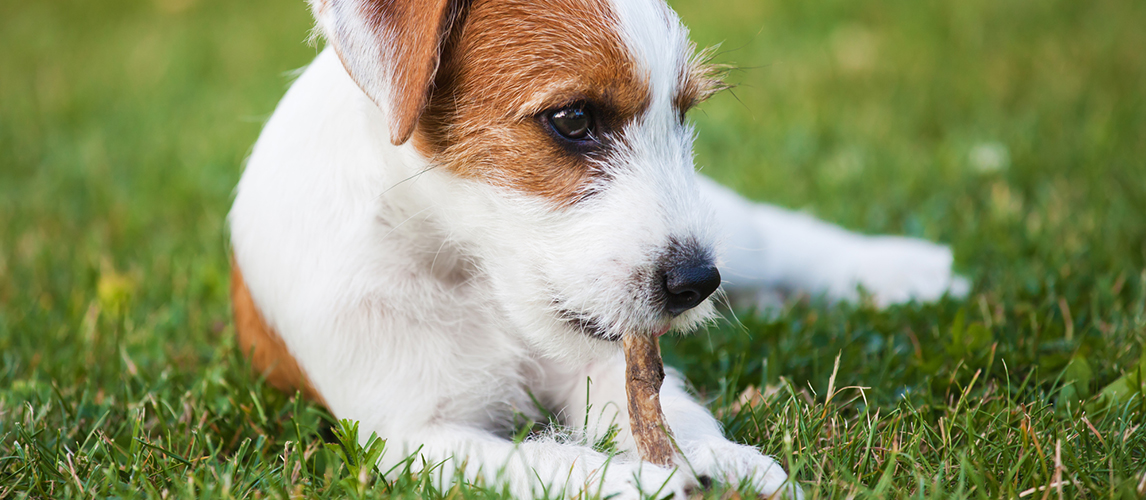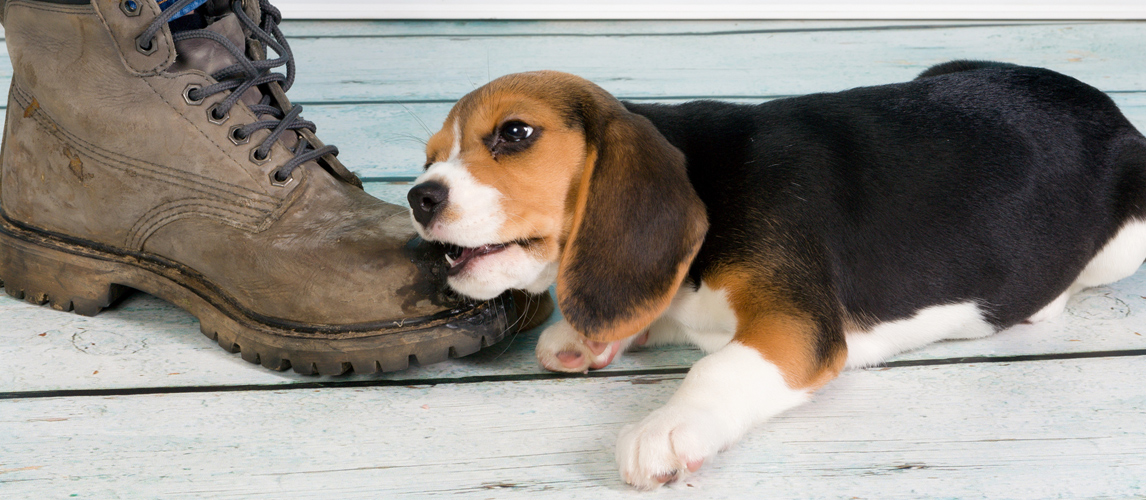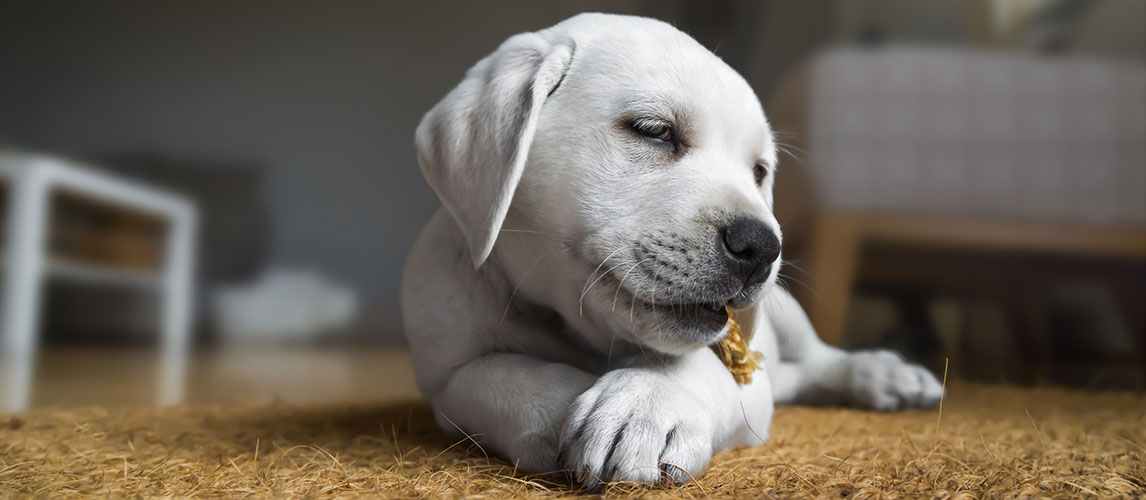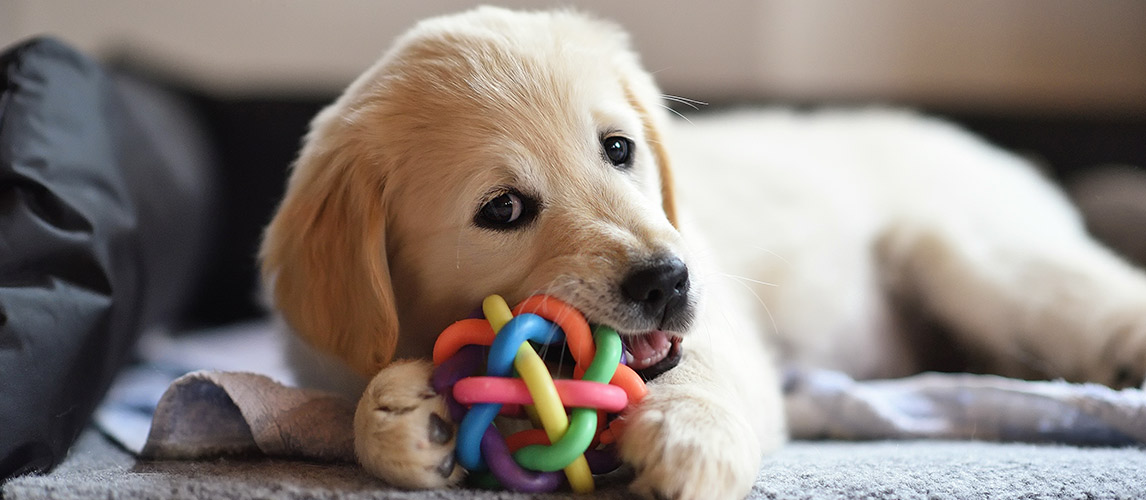Dogs, and especially puppies, love to chew. One of the reasons for this is because puppies use their mouths to explore and learn about the world around them. While chewing is a normal behavior, it becomes undesirable when it becomes destructive or is aimed at inappropriate items and people.
Left unchallenged inappropriate chewing can lead to the destruction of furniture, personal items, and children’s toys. It can also, more importantly, lead to medical problems for your dog and affect the positive relationship and bond that you have with them. Before we look at five ways to stop inappropriate chewing, let’s get a better understanding of dog’s teeth.
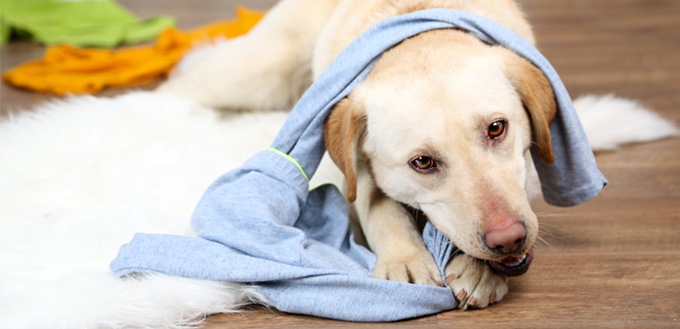
Your Dog’s Teeth
Teething is a painful process for puppies, just as it is for babies and toddlers. Chewing is one of the ways in which puppies help teeth to come through and find relief from the pain of cutting teeth. The deciduous teeth arrive from three weeks of age. The process is usually completed by eight weeks. Once your puppy reaches between four and six months of age, you should notice that these teeth are starting to be replaced by their permanent teeth.
While they are teething, a puppy’s gums can become very irritated and sore. Chewing helps to relieve this irritation and discomfort. As your dog grows the intensity and amount of chewing should reduce, although even older dogs like to chew, and appropriate chewing is good for their jaws and dental health.
So, how do you discourage or stop inappropriate chewing and encourage your puppy or older dog to only chew appropriate items? Here are five ways that you can achieve this and save your shoes and sofa from your dog’s teeth.
Rule Out Medical Issues
If your puppy or older dog suddenly starts chewing inappropriate objects, the first thing to do is rule out potential medical issues. There are a range of medical problems that can cause this behavior to appear. Nutritional deficiencies caused by intestinal parasites, other medical problems, or inappropriate diets, can cause pica. This is often misinterpreted as inappropriate chewing.
Problems with digestive system and intestines can cause nausea. When this occurs, dogs often chew inappropriate objects to make themselves sick. Blockages can also cause dogs to begin this behavior as they try to dislodge the problem. If you notice these behaviors, especially where they haven’t occurred previously, you should speak to your veterinarian before you take any other action.
Related Post: Best Bones for Dogs
Puppy Proof Your Home
Prevention is always the best option and while you cannot remove everything that your puppy might chew, there are some things that must be kept out of their reach. Our homes are full of items that are toxic to dogs and while our focus is on stopping inappropriate chewing, it is important to keep your dog safe in the meantime. Household cleaners and other chemicals should be appropriately stored in cupboards that cannot be accessed by your dog. Electrical cords and wires should be blocked off or covered where possible, and equipment put away when it is not in use. Think in terms of falling hazards as well as chewing hazards. If your dog chews the cable to your iron, not only could they electrocute themselves when it is turned on, but they could cause the iron to fall on them and become hurt even when it is turned off.
Check the plants in your home as well. Many plants are toxic to dogs if they are chewed. Place them out of the way or in rooms that your dog does not go in alone. Again, consider the potential for falling hazards when placing plants on tables and units.
Lastly, consider items of temptation and curiosity. Children’s toys, shoes, socks, and things like bags are new and exciting experiences to young puppies that just need to be explored. Moving them out of their reach and blocking off access to rooms that haven’t been puppy proofed helps to reduce the risk of inappropriate chewing.
Encouraging Appropriate Chewing
The best way to avoid inappropriate chewing is to provide lots of things your dog can chew. All dogs are different and have their own preferences when it comes to chew toys and bones, but it is important that what they have is age and size appropriate and safe for them to chew.
Beef bones and rawhide, while fun for your dog can cause problems. This is mainly because they can be broken down over time and the small pieces, if swallowed, can become lodged in the esophagus or small intestine. These types of chews and treats should only be given when you are able to supervise your dog, regardless of their age. Chicken bones should be avoided at all costs because they splinter very easily. The sharp fragments can cause a host of problems if swallowed including puncturing your canine companion’s gastrointestinal tract. Dental chew sticks are a great alternative to bones as they encourage good dental health, as well as being fun for your dog to chew.
Related Post: Best Rawhide For Dogs
Toys that are provided for your dog should also be chosen with care. Kongs and balls need to be size appropriate to ensure they do not get lodged in your dog’s mouth or swallowed. However, it is important to ensure that they are not so big that your dog cannot pick it up or get a grip on it with their jaws. All toys should be checked regularly for signs of damage and should be removed as soon as any damage is found. This reduces the risk of your dog swallowing or choking on small pieces of rope or plastic.
Finally, do not use inappropriate items as toys. Old shoes might be fun, but your dog will not be able to distinguish between a shoe he is allowed and one that they are not. There are also chemical and other hazards to consider with items that are not specifically designed for dogs.
Related Post: Best Chew Toys for Puppies
Play Time
Inappropriate chewing is often the result of boredom. Young dogs especially, should not be left unattended for long periods of time. When they are left they should have plenty to keep them busy, such as food puzzle balls. When you are home, setting aside time for play and exercise. This helps alleviate boredom, keeps your dog fit and healthy, and improves the bond between you.
Related Post: Best Dog Puzzle Toys
Discouraging Inappropriate Chewing
You are going to be unable to move everything that your dog shouldn’t chew, so occasionally, puppies especially, are going to find inappropriate things to chew. How you approach this when it happens can make a big difference in the long term. Firstly, while you don’t want to get into a fight with your dog over such items, you cannot just ignore the behavior either.
Inappropriate items should be removed from your dog as soon as you see them chewing them. Commands such as drop, leave, or stop should be used so that your dog knows what they have is not appropriate. Replace the object with a toy that they are allowed and then praise them when they turn their attention to that item.
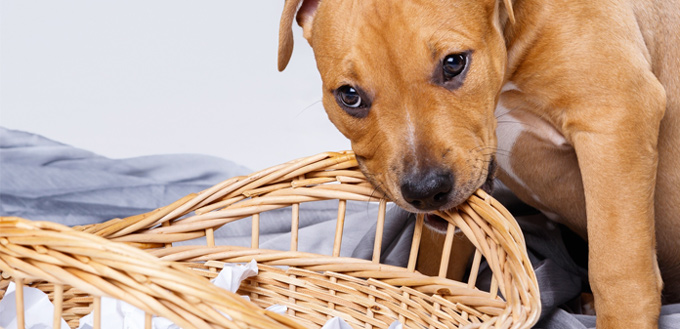
Understanding the difference between what they can chew and what they cannot takes time. But, if you are consistent in your approach your puppy will learn the difference and this should prevent chewing problems when they are older.
It can be more difficult with an older dog if the chewing pattern is already established, but this does not mean you should give up trying. Time, patience, and consistency of approach are still key to positive results. However, you may find that using taste deterrents aids the process. This may be specifically helpful where the inappropriate chewing is directed towards items such as furniture that cannot simply be moved. Make sure you use a taste deterrent that is suitable for dogs and use in conjunction with the process outlined above.
And, Finally
By following these tips, you can encourage your dog to chew appropriately and to learn the difference between their toys and your possessions. Remember that developing appropriate behaviors in dogs is easier the earlier you start. But, you can still have positive results with older dogs if you put in the time and effort needed.
Sources:
- Chewing: How to Stop Your Dog’s Gnawing Problem, Humane Society
- Elisabeth Weiss, How to Stop your Dog from Chewing Things it Shouldn’t, wikiHow
- Paisley Lunchick, RVT, How to Stop a Dog from Chewing, American Kennel Club



